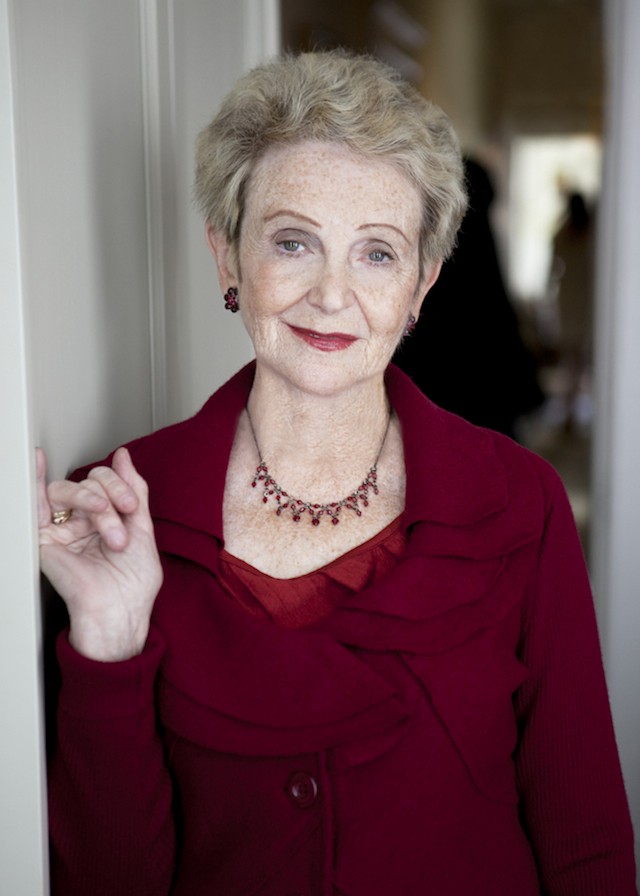You Won't Believe The Latest Stupid Trend Out Of Brooklyn

“The thick, flowing beards adorning hipsters from Williamsburg to Park Slope are driving follicly-challenged New Yorkers to a little-known but growing field of plastic surgery — facial hair transplants…. [Plastic surgeon Yael Halaas] said an increasing number of ‘hip’ and ‘fashionable’ young professionals in their 20s and 30s are seeking the procedure. ‘I get a lot of detail-oriented people — artists, architects,’ the doctor said, noting that beard-centric neighborhoods such as Williamsburg, Bushwick and Park Slope have each delivered four to five clients to her practice in the past year.”
Pistachio Tie Error Corrected
“An article on Friday about Ahmed Muhammed Haza al-Darbi, a Saudi detainee at Guantánamo Bay, Cuba, using information from a military spokesman, misidentified the source of the pistachio-colored tie that Mr. Darbi wore at the court hearing in which he pleaded guilty to terrorism-related offenses involving a 2002 attack by Al Qaeda on a French-flagged oil tanker off the coast of Yemen. It was given to him by his civilian lawyer, Ramzi Kassem; Mr. Darbi did not select it from a bag of ties made available to detainees for such hearings.”
Moon Rocked
“Record-Breaking Meteorite Crash on Moon Sparks Brightest Lunar Explosion Ever” is the headline, and if the actual video of it is something less graphic and forceful than anyone who hates the moon (which is everyone with any sense) might desire it is still, as the joke goes, a good start.
Post-Structuralist Mayor Disregards Your Epistemological Conjectures
“I’m not interested in the construct of what you, as an individual, think many New Yorkers think. I say that with absolute respect. I talk to New Yorkers all the time, my colleagues talk to New Yorkers all the time. Let’s not get into this concept of any of us will speak for all the people.”
— Mayor de Blasio isn’t gonna play your gotcha games.
Made-Up Twitter Account Totally Made-Up
#1: Don’t apologize for being late with a Starbucks latte in your hand.
— GS Elevator Gossip (@GSElevator) December 19, 2013
Last night, the author of the “parody twitter account” (*shudder*) called @GSElevator — that’s short for Goldman Sachs Elevator, you see — was escorted out of the closet by Andrew Ross Sorkin.
To anyone who’d ever met anyone who worked at Goldman Sachs, it was obviously fiction, as in, made-up, invented, concocted. So was his writing on fashion and manhood at Business Insider: It was sometimes hilarious but almost never had the ring of truth. In recent times, the account has grown quieter and less specific, although apparently it remains very popular, which is usually the way things go as the outing hammer comes lowering down.
This person’s book, Straight to Hell: True Tales of Deviance and Excess in the World of Investment Banking, doesn’t drop till October. (His name, BTW, is John Lefevre.) But already his agent and publisher are doing that classic spin:
The fact that Mr. Lefevre was not a Goldman employee did not appear to dissuade his publisher, Touchstone, an imprint of Simon & Schuster, which said it had not been misled…. Mr. Lefevre’s agent, Byrd Leavell, said: “What matters is that every story in the book is true. John’s material he delivered is hilarious. The book isn’t going to live or die on whether he worked at Goldman Sachs for two months or not.”
Guess what? I already don’t believe the stories in his book, particularly given the long history of rigorous fact-checking in the memoir comedy industry, and plus that this dude spent years making things up for the sake of comedy. On the brighter side, he’s kind of hot though.
Unmaskings are the opposite of news because they take something that was exciting for everyone and make it exciting to exactly one person.
— Paul Ford (@ftrain) February 25, 2014
The Extra Woman
by Manjula Martin

One in an irregular series of profiles of fabulous older women.
The first time I met Adele Daniller, she kept offering me food. This was several years ago, at her home in Tarzana, CA, in what Los Angeles people call “the Valley.” I’d come to Daniller’s house with her daughter, Lydia Daniller, a photographer friend. After refusing a few rounds of snacks, I got up to go to the bathroom and ended up wandering through the Daniller’s living room. It was a hot afternoon, and the lights were off. The cool, dark room felt soothing. On every wall and in every nook was art: sculptures, framed paintings, textiles and objects collected by Daniller and her husband, who is a doctor. The home felt to me like other homes I’d only been to in the upper reaches of Manhattan: a family seat of upper-middle-class intellectuals, people whose book and DVD shelves broadcast a valuation of the arts that can seem disproportionate to their stodgy day jobs.
Back in the kitchen, small talk with Daniller turned from her daughter’s dating life to our careers. I had assumed she was a housewife, but Daniller slipped me her business card. Her job title was Background actor and laugher.
“You are a writer?” she said. “Oh, I could tell you some things about the film business!”
Daniller has worked on: “Everybody Loves Raymond,” Angelina Jolie’s breakout vehicle Gia, TV stalwarts like “The West Wing” and “ER.” She’s been a face in the crowd in courtrooms, street scenes, restaurants, airports, and funerals — usually nonspeaking roles, although on occasion she’ll be given a few lines, as she was on “Entourage.” One of her favorite gigs is as a laugher. Sitcoms often hire an audience during rehearsals so actors can get a sense of the timing for their jokes. Daniller enjoys edgier work as well — she’s the old lady lying on the floor in flapper regalia in David LaChapelle’s orgiastic photograph “Berlin Stories.”
In 1957, Daniller’s obsession with the movies took her from Europe to Los Angeles as a 19-year-old exchange student. In order to afford UCLA’s non-resident tuition rates, she landed a secretary job at Columbia Pictures in the television division, Screen Gems, out of which came hit shows such as “The Donna Reed Show,” “Gidget,” and “The Flying Nun.” From there, her language skills kept her well employed, usually in secretarial and other pink-collar positions, often in the film business. She never made it on-screen. In her twenties, Daniller spent time in Paris, Mexico City, and New York. She met her husband, Avron (a “nice Jewish doctor”). They had three daughters and eventually moved back to LA in the late 80s. After Lydia, who was the youngest, left for college in 1996, Daniller was “moping around the house” and needed a distraction from her empty nest. Her eldest, Tanya, suggested she pick up some work as an extra.
“I had no idea what that was. I just wanted to get out of the house — specifically the kitchen,” said Daniller. The next day Tanya got her the information for Central Casting (which is a real casting company, not just a generic term), and Daniller went down to Burbank and signed herself up.
“I was so naïve,” she said. “I thought they would call me. For six weeks I waited, but I was supposed to call.” She eventually figured out the mechanics of the call-in system, and has been working steadily since.
Daniller speaks with a sophisticated European accent. She is now 74. She’s fluent in English, German, French, Jewish Grandma, and LA showbiz-speak. Her Italian, Spanish, Polish, and Hebrew are “passable.” Daniller likes to ends her sentences in exclamations such as “And that’s that!” or a conspiratorial, “Would you believe?” During our interview, she mostly wanted to discuss her newest grandchild, the “sweetest, gentlest, most darling” thing, but once we got talking she was equally excited to dish about the ups and downs of being an extra, how to make it as a woman in Hollywood, and which megastar is secretly a b-i-t-c-h.
Working Girl
If you want to know what’s really going on in any industry, its lowest ranking workers can tell you.
In the seventeen years Daniller has been a background artist, she’s witnessed the downward trend in Los Angeles film production jobs: other states and countries now offer better economic incentives, to lure film productions to their locations.
“I used to be so busy in films, oh my,” she said. “If I were to give you all the names of all the films, you’d be amazed. Now? It’s mostly television.” Daniller holds a special place of scorn for former California governor Arnold Schwarzenegger, who has similarly deprived his own state of film tax revenues. “The moment he left office, he had the audacity to go to Morocco and do two films, would you believe? He’s a real piece of work,” she said.
Even before the decline in L.A. production, being an extra has always been a tough gig. Daniller only recommends it as a sole source of income if “maybe you’re 18 and you work a lot and you live with your parents. But if a person is in their late twenties and is non-union, it’s pretty impossible.”
Union cards are hard to get for extras, but they bring better day-rates and a chance at health insurance. In typical LA fashion, the final straw that caused Daniller to get serious about solidarity was a desire to be paid for her mileage when driving to and from jobs through Valley traffic. “I finally said, enough is enough!” she said. “I want to be paid for my travel and my work. And that’s that.” Since 2007, she’s been union (the recently merged SAG-AFTRA) and proud.
It helps to have a doctor for a husband; according to a 2008 study on aging performing artists, a Los Angeles-based union performer Daniller’s age could expect to earn about $4,000 a year — and it gets lower as actors get older. Competition is steep. There are few roles for actors of a certain age to spread between the 10,000 active AFTRA members over the age of 62. And that’s just those who’ve earned enough hours to be in the union.
Playing Against Type
As Hollywood characters go, Daniller doesn’t quite fit any standard “old lady” type. She’s neither a declining dame like Norma Desmond nor a rapping-grandma punchline. In conversation, she vacillates between playing the ultimate insider — debating the relative merits of artsy cinematographers — and displaying the attitude of a perpetual outsider.
One of Daniller’s biggest role models (and she has many) is Hollywood nonconformist Kathy Bates, who broke the mold for leading ladies with her 1991 Oscar win for Misery after decades of rejection by casting directors.
“They told her she was too fat,” Daniller said. “Well, guess what? Her first big film, and she got the Oscar for it! Imagine. Years of being told you are not suitable for the screen — you’re too fat, too short, you walk like a duck — and you get the Oscar.”
I asked Daniller if she sees a role for Hollywood in addressing sociopolitical issues like sexism. “There shouldn’t be one!” she said, and then went on to talk about the lack of female writers in Hollywood. (Every few years, the Writers Guild of America releases a survey showing that the rates of women and people of color who are writing films and television shows are dismal, and not improving.)
Also not cool with Daniller: celebrities who don’t give money to charity. In a whispered tone she tells me of a certain pretty female movie star who projects an American sweetheart image but has a reputation as being uncharitable, both to plebes (she forbids extras to speak to her, even when necessary on set) and to the good causes her peers readily donate to.
Daniller is filled with such tabloid-worthy tidbits — just for the record: some good stars to work with are former extras Dustin Hoffman and Brad Pitt and classy mature ladies Lily Tomlin and Angela Lansbury. And if you should be so lucky as to find yourself with the opportunity to even be near Sharon Stone, you should take it — “she’s so gorgeous, so intelligent.”
Advice for Starlets
Daniller was overflowing with advice about her industry, so I asked her if there’s anything she wishes an older woman had told her when she was young. She sidestepped the personal aspect of question but responded with a Cosmo slideshow’s worth of advice for women in the entertainment industry. Among the gems:
“Tell the girls to please always remain dignified, no miniskirts.” It’s important to wear a skirt, though, just make sure it doesn’t go above the knee: “Some of those girls look so cheap. My goodness.”
Always wear heels. “But stay away from those high heels — the 6-inch heels, I call them hooker heels! It just looks vulgar.”
More on shoes: “Never wear strappy shoes when you are dancing for four days” — something she had the misfortune of doing until her toes bled while on set for Mr. and Mrs. Smith.
“And another thing is that now nobody seems to be wearing hose! The female leg looks so much better with hose,” she said.
Speaking of sexism in Hollywood, after you’ve got those beauty tips down, ladies, sharpen your other skills: “If there are no parts for you, write one. Write a script, take some screenwriting classes. Persevere. If the door is slammed in your face, go in the window. And that’s that!”
Flashbacks
Success tips aside, the movie business is one that thrives on the promise of stardom, and it can be brutal to its bit players. A 1929 silent film, The Life and Death of 9413, a Hollywood Extra, takes a satirical look at the biz through the story of an aspiring actor who, big surprise, comes to Hollywood to be a movie star. Instead, he becomes “9413,” his registration number for casting calls.
The Life and Death of 9413… was made for a reported $97 by two European filmmakers who immigrated to America between the world wars: Slavko Vorkapić, from Serbia, and Robert Florey, originally from France. (The project’s cinematographer was Gregg Toland, later of Citizen Kane fame). The 15-minute film is worth watching just for its creepy/beautiful handmade sets and photography, as well as its critique of the dehumanizing Hollywood studio system.
But when I watched the film, I’d just spoken with Daniller about the Holocaust, and creepy quickly turned dark in my viewing experience.
In the film, 9413 and the other aspiring extras are herded into endless “cattle calls.” Their skin is marked with their registration numbers — on their foreheads — and they are lined up against a wall one by one. Under a stark spotlight, each extra is ordered by a dictatorial, disembodied hand to stand, sit, smile, speak, whatever he’s told. The stress of it kills 9413. In the afterlife a kinder, gentler hand wipes the number from his skin.
Like many Holocaust survivors, Daniller doesn’t like to talk much about the war — “that’s for another conversation, another time,” she kept promising me. Then we ended up talking about the war.
Her linked childhood experiences of the war and the movies are sometimes impossible to uncouple, even seventy years later. “My husband refers to it as imprinting,” said Daniller. “When I escaped to Vienna, I was only four years old. My mother took me into the movies four, five, six times a week, whenever she was able to. I saw two or three films a day. And when you are seeing the screen regularly, it influences you.”
Daniller’s afternoon trips to the moviehouse were about much more than escaping into fantasy worlds; they were also clandestine meet-ups for her mom and dad. Lydia later explained to me that after they escaped to Vienna from Poland, Adele’s parents had to live apart in order to avoid detection as Jews. “It must have been safer for a woman and child living alone, with Polish accents, than for them all to live together as a family,” said Lydia.
During Daniller’s family outings to the movies, Gene Kelly, Ava Gardner, and their peers became as familiar to her as childhood friends. At the movies, she said, “there’s a feeling… not of safety, but of understanding. I understood what was going on in movies, because that was my life.”
And so Daniller remains true a believer in the Hollywood dream, more than any starlet with an Oscar gleam in her eye. “Hollywood is an illusion,” she said, as though the description was a compliment. “It’s magic. Here, you lose yourself. Here, you are able to take on other identities.”
A Star Is Born
It’s hard to track down Daniller’s film appearances — that’s the nature of a good extra, they’re designed to go unnoticed, un-Google-able, unimportant. Daniller doesn’t work much in music videos, but one of the most accessible places to see her work is in Marilyn Manson’s 2001 video for “The Nobodies.”
The video is a pastiche of goth imagery: Manson plays the evil headmaster of an institution filled with misfits, and also plays a tree (?). Essentially, he writhes and sings in front of the camera in various creepy outfits. At points, he’s attended by two older women dressed in white nun-like outfits. One of them is Daniller.
Manson’s lyrics intone what could be a theme song to the life of a Hollywood extra: “We are the nobodies, wannabe somebodies.” At the two and a half minute mark, there’s a clear shot of Daniller as she bends to kiss Manson’s ring. Her eyes are wet and reflective. Her gaze leaves Manson’s hand only to move upwards, to the edge of the frame, catching light.
Manjula Martin is the co-editor of Scratch Magazine. Her writing has appeared in the Virginia Quarterly Review online, Modern Farmer, The Rumpus, SF Weekly, POZ Magazine, and many now-defunct blogs. Twitter: @manjulamartin. Photo by Lydia Daniller.
New York City, February 23, 2014

★★★★ A crushed rat, a large one, lay in the street, its guts a chopped-looking red pile beside it. The morning was bright and mild; the scaffolds were still dripping. Half-trapped plastic bags stuck out of the dwindling snowbanks, along with every other sort of garbage. Birds sang on the Broadway median. The gutters were mucky. Every transition from the warm sun to the still-chilly shade was a binary switch from pleasant to unpleasant. Someone outside a bistro on the sunny side of the street had gone ahead and hazarded bare legs and a miniskirt. Whole expanses of the schoolyard playground were still surfaced with snow, or with the thick layer of fat ice-crumbs that the snow had become. Orange cones had been put out on one of the snowy spots, to emphasize the obvious. The toddler, in sneakers, was determined to get off the cleared pavement and into the crunchy parts. The map of the United States on the ground was glaciated from end to end, save for one swath of Wisconsin and Iowa beside the drain cover, and what might have been part of the Kentucky-Tennessee border. On the far side of the frozen territory, a woman sat on a bench painting in a notebook. The sheeting on the rising apartment building glowed in the afternoon light, casting its reflection across a string of puddles. The toddler kicked an ice lump back and forth for minutes upon minutes, then stomped it into particles.
Max Tundra, "I Wanna Be Your Lover"
“A few years back, Max Tundra spent a day recording a cover of Prince’s ‘I Wanna Be Your Lover’ entirely with hand-played keyboard parts and no samples. Since realizing that it isn’t available online anywhere, he posted a very silly ‘phoned-in’ video with all the charm of something you might come across on public-access TV at 2 AM.”
— Catch me on certain days and I will argue that Mastered By Guy At The Exchange
is the greatest album from the the first decade of this century, and most of those days I will actually be quite serious. Anyway, this is pretty enjoyable.
The E Train: A Colloquy

Chat has been punctuated and formatted where appropriate.
Balk: Today I learned that the E “is particularly popular among sleepers in winter, because it runs 24 hours a day and is completely underground.”
Choire: I hate the E most of all.
Dusty: Yeah the E is pretty good for a nap.
Emma: Name one time you were happy to see the E.
Choire: I took it to JFK… ONCE.
It was pretty intense.
Adam: Fuck the E.
The E doesnt run to JFK.
It stops at WTC.
The E always shows up when i am waiting for the C.
Fucking useless garbage train.
Choire: The other way, Adam.
The E is seven stops to Jamaica from LIC.
Adam: Don’t believe you.
Edith: Plus all the Es are new, so she always glides in all shiny and pretty, like “look at me aren’t I nice” but no one wants you, you stupid bitch who goes nowhere.
Emma: Lol.
Same.
No time for that.
Do YOU have feelings about the E? Probably.
Photo by Mike Knell, via Flickr
Where Are The Young People On The Internet?
Where Are The Young People On The Internet?
Facebook wants you to think lots of kids still use it while YouTube doesn’t want you to think too much about the fact that lots kids actually do still use it. It’s a crazy world!
